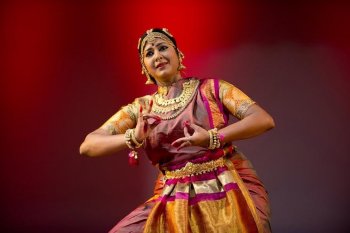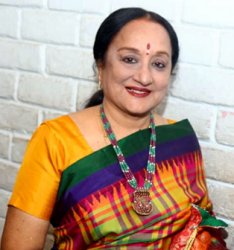
|   |

|   |
Research and Re-creation in Dance April 6, 2014 For me, the formal and informal performance history of Bharatanatyam elicits more fascination than ritual dances. Ritual has its limitations on the stage. Like the Kauttuvams. Interesting visuals they may be, but for me they have no soul when taken out of context. The charm of old Palace repertoire is unbeatable. I recall with utmost pleasure my interview with Pandanallur Jayalakshmi decades ago. Imagine if one were to speak to a performer who had danced the Dhanike Todi ragam varnam in the presence of Sivaji maharaja of Tanjavur! The varnam was composed in praise of him.... Such was my excitement to hear Jayalakshmi reminiscing about a rare varnam when I visited her in the late seventies. She sang the varnam composed exclusively for her by Meenakshisundaram Pillai. In raga Vachaspathi, it is in praise of her husband, the Sethupathy or Raja of Ramnad. I have written more about this meeting in my book. I had also seen pictures of mural paintings of court dancers of the 18th century in the Ramanathapuram palace taken by my good friend V.K. Rajamani. They were testimony to an active royal pastime....dance and music programs attended by the king. It was not difficult to understand that that kingdom was a seat of music and dance, second only to Tanjavur. I think such varnams are historically important and their worth is not diminished simply because modern India decried royalty and abolished princely states. We owe more than we can acknowledge to our royal past. Our ancestors were all citizens of big or small kingdoms. Through the length and breadth of India, every artist and artisan enjoyed royal patronage. But for the princely states being end users, our weavers, jewellers, architects, dancers, painters, sculptors and musicians would not have excelled in their special skills. If many things survived even after the abolishment of royal kingdoms, we must feel lucky. I looked seriously at the Nayak dynasty of South Indian history rather closely when I presented a paper in Dallas at a conference on the dance and music of that period which I titled 'Under the Royal Umbrella.' That was nearly a decade ago for SARII a South Asia initiative. I found a vast treasure house of information on this subject. My guiding light was the very exhaustive book Tanjore as a seat of music by Dr. Seetha. She had done a great job. I also studied Nayak history in Tamil by Kudaivasal Balasubramanian and tried to understand some aspects from other published manuscripts from the Saraswathi Mahal Library.  Swarnamalya
Swarnamalya, the well known dancer and researcher, has recreated some of the dances of the Nayak era. She has also examined the cultural influences from outside on all the arts of the period. The nice thing about this era is the voluminous literary evidence available about the arts of dance and music. Writers of the court, palace dancers and musicians who were also courtesans and favourites of the kings have chronicled the life and times of the Nayaks. Raghunatha Nayak was the most prominent and exemplary king, and the court poetess Ramabhadramba was the most prolific chronicler. The kings and palace nobles as also the women, who were obviously courtesans, composed monumental literary works which were sung and enacted. Poems and operas which were known as Yakshaganas were very popular genres. Well, I compare the Nayaks to the Medicis of Italy. They helmed an awesome Renaissance. A list of dancers and what they performed is found in Nayak period literature. Songs too, in Telugu and Sanskrit, and other languages are part of these works. Culling out a selection, tuning them and presenting them on today's stage is no mean task. Swarnamalya has with the help of teachers, scholars, musicians and linguists, re-presented dances like Mukachali, Jakkini, Perani, and so on, with credibility. Her work has lustre as it is fresh, and purports to be close to the original as imagined. Yes, such work needs imagination, considering the limited given facts about the actual performance in manuscripts. One gesture here, another stance there in paintings and sculpture can give valuable clues like pieces in a jigsaw puzzle. However, a great help in reconstructing lost dances is the music, if one is lucky to find a manuscript with notations. Not easy at all! In recreating old dances, one has to be very conscious of where, when and for whom the dances were performed. Once that is clear in your mind, it is possible to present a credible version. Getting first hand exposure to the old style... I mean Bharatanatyam of the early twentieth century when Nattuvanars were supreme and dancers were hereditary... helps. Swarnamalya has done just that working with Jeevarathnamala, the daughter of Rajalakshmi, who, along with her sister Jeevarathnam were among the first to perform 'Indian NAUTCH' in Madras. Well, something new is always welcome. And for my tastes, if it is a retro style with good music, it is worth a good viewing. The program titled FROM THE ATTIC by Swarnamalya is one such. She is inspired by her research, and has worked hard on the project. Dancers as researchers... that is an idea that I endorse... an idea which can broaden horizons and bring out the artistic explorer in you. Go for it, dancers out there. There are treasures aplenty waiting to be discovered by sincere seekers. Remember, there are no short cuts in this avenue!  Lakshmi Vishwanathan, a prime disciple of Guru Kanjeevaram Elappa Pillai, is an exponent of the Thanjavur style of Bharatanatyam. She is also a trained vocalist. She is the author of several acclaimed books: Bharatanatyam - the Tamil Heritage, Kunjamma - Ode to a Nightingale, Kapaleeswara Temple, Women of Pride -The Devadasi Heritage. Her film 'The Poetry of Dance' was commissioned by the Festival of India. The Mamallapuram Dance Festival started in 1991 was Lakshmi's brainchild. She has served on several arts committees. She has served as Vice President of Music Academy (Chennai) and is a member of South Zone Cultural Centre. Comments Akka, I'm overwhelmed by your compliments. All the more because you are a scholar and artiste with great taste and love for the hereditary forms. I'm inspired to do more and do better. Thanks to the wishes of artistes like you, I'm feeling responsible towards my commitment. - Swarnamalya Ganesh, June 24, 2014 Post your comments Pl provide your name and email id along with your comment. All appropriate comments posted with name and email id in the blog will also be featured in the site. |